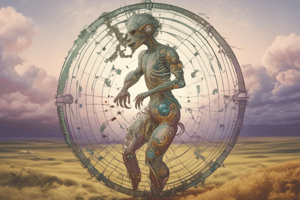Podcast
Questions and Answers
What are the two major mechanisms behind a population evolving?
What are the two major mechanisms behind a population evolving?
catastrophism and gradualism
What is catastrophism?
What is catastrophism?
a sudden, often destructive, event that leads to the die-off of many organisms at one time
Who developed the theory of catastrophism?
Who developed the theory of catastrophism?
Georges Cuvier
What is gradualism?
What is gradualism?
Who developed the theory of gradualism?
Who developed the theory of gradualism?
What is an adaptation?
What is an adaptation?
What is the biological definition of evolution?
What is the biological definition of evolution?
What is heredity?
What is heredity?
What are genomes?
What are genomes?
What are the major factors that cause genomes to change over time?
What are the major factors that cause genomes to change over time?
Who are two individuals who contributed to the development of the Theory of Evolution?
Who are two individuals who contributed to the development of the Theory of Evolution?
Why is evolution important?
Why is evolution important?
What are the three factors that act on the inheritance of traits in the evolution of a population?
What are the three factors that act on the inheritance of traits in the evolution of a population?
Define natural selection.
Define natural selection.
What is random genetic drift?
What is random genetic drift?
What is sexual selection?
What is sexual selection?
Name and describe the three major types of evolution.
Name and describe the three major types of evolution.
Provide an example of divergent evolution.
Provide an example of divergent evolution.
Provide an example of convergent evolution.
Provide an example of convergent evolution.
Provide an example of parallel evolution.
Provide an example of parallel evolution.
Flashcards are hidden until you start studying




